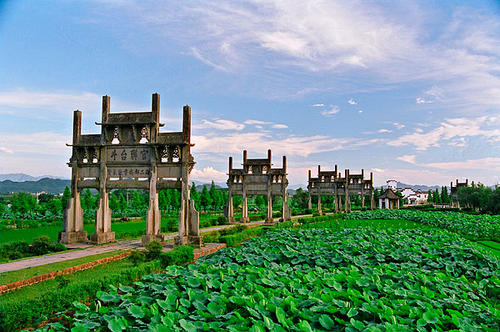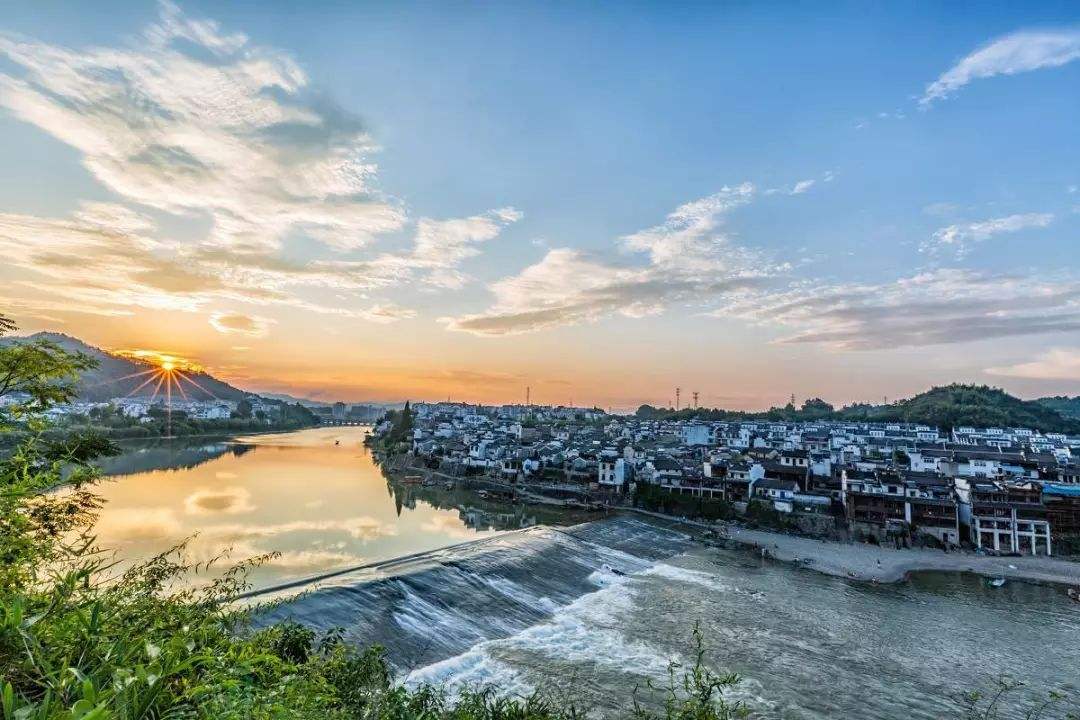Chinese Name: 歙县 Pronunciation: shē xiàn
Building Time: In the Qin Dynasty (221 B.C.)
Building Function: Residential area
Best Visiting Season: Spring and Autumn
Address: She County, Huangshan Prefecture, Anhui Province
Suggested Visiting Hours: 1-3 hours for Tangyue Archway Group; 2 hours for Yuliang Dam; 3-4 hours for Shitan Village
| Scenic Area | Ticket Fare |
| Tangyue Archway Group | 100 yuan |
| Yuliang Dam | 30 yuan |
| Xin'an River Landscape Gallery Scenic Area | 50 yuan |
| Shitan Village | Free |
| Places | Time |
| Tangyue Archway Group | 07:30-17:30 |
| Yuliang Dam | 09:00-17:00 |
| Xin'an River Landscape Gallery Scenic Area | 08:00-17:00 |
| Shitan Village | All Day |

She County is located in Huangshan City, Anhui Province, covering an area of 2,122 square kilometers. It was established in the Qin Dynasty and was considered as the political, economic, and cultural center of ancient Huizhou. In 1986, She County was announced as the National Historic and Cultural City by the State Council for its profound history and splendid cultures.
She County, together with Pingyao in Shanxi Province, Lijiang in Yunnan Province, and Langzhong in Sichuan Province, is known as the four best-preserved ancient cities in China. As the main birthplace of Hui Culture, Huizhou merchants, and Hui cuisine, She County owns a great number of ancient archways, ancestral halls, and dwellings. And it also enjoys the reputation of “the Hometown of Hui Ink” and “the Hometown of She Inkstone” in China.
According to some stone tools unearthed in She County, there were human activities here as early as in the Paleolithic Age. After Qin Shi Huang (the first emperor in Chinese history) unified China in 211 B.C, it was officially announced as She County, which was under the jurisdiction of Huiji Prefecture (now Shaoxing, Zhejiang Province).

Located 6 kilometers away from the western suburb of She County, Tangyue Archway Group consists of seven arches, crossing the stone road in the countryside one after another. In April, rapeseed flowers on both sides of the road are in full bloom, making the archways even more majestic. Not far from Tangyue Archway Group is the Garden of Bao’s Family, where one could enjoy varieties of bonsai.
The arches represent different meanings. According to the order of loyalty, filial piety, women’s chastity, and benevolence, the arches arrange from the two ends to the middle. The center one represents benevolence. Archways were built in ancient times to honor people of outstanding merits and virtues. And therefore, each one of them is of cherished value and there are touching stories behind them.
The seven arches include Bao Can Filial Piety Archway, Kindness and Filial Archway, Bao Xiangxian Archway, Bao Wenling’s Wife Wang’s Chastity Archway, Bao Shufang and His Son’s Benevolence Memorial Archway, Bao Wenyuan’s Wife Wu’s Chastity Archway, and Bao Fengchang Filial Piety Archway. Among these seven arches, the first three were built in the Ming Dynasty, while others were built in the Qing Dynasty.
Beside the archway group stand two ancestral halls, enshrining Bao’s Family, the dominant family in Tangyue Village. Qingyi Hall is the only ancestral hall that was built for women in China. It was built to honor the chastity of the women of Bao’s Family. They lived alone waiting for their husbands when Huizhou men went out for business and were far away from home for a long time.

Yuliang Dam is located in Yuliang Village, Huicheng Town, She County. With a history of about 1,400 years, it was built in the Tang Dynasty and was rebuilt in the Ming Dynasty. It is the largest water conservancy project in She County in ancient times and one of the famous water conservancy projects in ancient China.
Yuliang Dam is of great significance in that it not only discharges floods and prevents droughts, but also maintains normal navigation. It is called “the Birthplace of Huizhou Merchants” since Yuliang Dam was the place where Huizhou merchants sailed from here for the prosperity of their families During the Ming and Qing Dynasties.
Yuliang Dam was listed as the fifth batch of major cultural relics that are under national protection by the Chinese government.

Shitan Village is an administrative village under the jurisdiction of Xiakeng Town, She County, covering an area of 0.2 square kilometers. People of ancient Shitan were good at doing business. In ancient times, Shitan Village served as an important channel for Huizhou merchants in She county to travel to Hangzhou via Xin’an River.
There are many ancient ancestral halls, temples, bridges and ports in the village. Xuliang Hall is one of the most representative ancestral halls in Shitan Village. It was built in the Ming Dynasty. The Xuliang Hall is characterized by the 100 beams in the building, and therefore, it is also known as “Bailiang (One Hundred Beams) Hall”.
Apart from ancient architecture, Shitan Village is also a famous scenic spot for rapeseed flowers in China, and it ranks the first among the top 100 photographic spots in Huangshan City. When spring comes, one can enjoy the boundless sea of clouds, magnificent mountains, colorful flowers and the antique dwellings in the village. The whole village is as beautiful as a fairy-tale world.
There are three bus lines at Huangshan Tourist Bus Station and one could take two regular lines, namely Bus No. 6001, Bus No. 6002 or Tunxi--She County Express Line to She County.
| Operation Hours | Time | Fare | |
| Bus No. 6001 | 6:30-18:00 | 1 hour and 13 minutes | 5 yuan |
| Bus No. 6002 | 18:30-20:00 | 1 hour and 10 minutes | 5 yuan |
| Tunxi-She County Express Line | 6:30-18:00 | 1 hour and 17 minutes | 5 yuan |
Chinese: 请带我去歙县。English: Please take me to She County.
If you go to She County from Huangshan Tourist Bus Station, it takes about 40 minutes. (About 100 yuan)
If you go to She County from Huangshan North Railway Station, it takes about 25 minutes. (About 55 yuan)
If you go to She County from Huangshan Railway Station, it takes 36 minutes. (About 85 yuan)
If you go to She County from Huangshan Tunxi International Airport, it takes about 45 minutes. (About 115 yuan)
